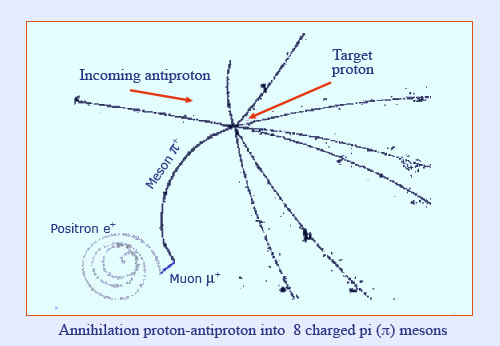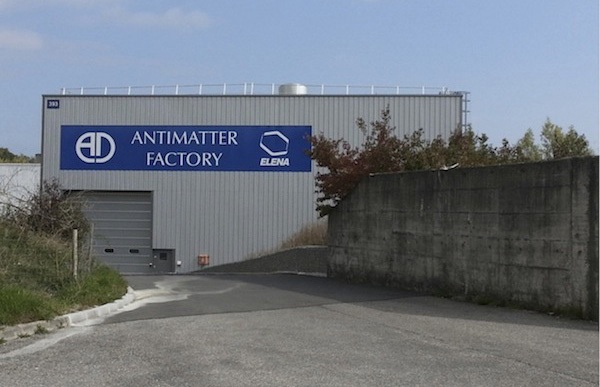Nature loves symmetry. However, one can not dream of a matter less symmetrical than the matter which surrounds us! Inside our atoms, protons carrying a positive electric charge + e coexist wih electrons carrying an equal but negative charge -e. Positive protons are confined within a tiny nucleus, while negative electrons move around in an infinitely larger space. Electrons are light weights compared to 1800 times heavier protons. The electrical current of our appliances and our lamps is a current of electrons, not of protons!
The discovery of Antimatter
A world built with negative protons and positive electrons would be just as plausible as ours. It is antimatter.
The antielectron – the positron – is produced in some rare radioactive decays called beta plus. It was the first antimatter particle to be observed in 1933 by the American physicist Carl Anderson.
In 1955, the antiproton was discovered in Berkeley (California) thanks to the Bevatron, a proton accelerator capable of accelrating protons to billions of electronvolts. The energy available during a collision was greater than twice the mass energy of a proton and allowed to create an antiproton and a proton at the same time. The discovery of the antineutron in 1956 followed shortly afterwards. Today protons and neutrons are known to be composed of elementary corpuscles, quarks. Antiprotons and antineutrons are made of antiquarks.
All the elementary corpuscles have their corresponding in antimatter. For example, neutrinos have antineutrinos as antiparticles. Thus, beta radioactivity generates electrons with antineutrinos-electrons.

An explosive mutual destruction
Energetic antiprotons have been produced at C.E.R.N by a powerful accelarator. This picture shows the trajectory of one of these antiprotons in a bubble chamber filled with liquid hydrogen whose protons are collision targets. The trajectory is interrupted by a collision with one of these protons.The collision is violent. The antiproton and the proton mutually destroy each other. The explosion generate 8 fragments, short-lived particles called mesons.
© IN2P3
Where is the antimatter?
There is a great symmetry between matter and antimatter. When an antiproton is created, so is a proton or a neutron. When a nucleus emits a positive antielectron, it simultaneously emits a neutrino that can be viewed as an electron without an electric charge. Conversely, when an antiproton is destroyed during an annihilation reaction, a proton or a neutron is conversely destroyed. Likewise, electrons and positrons annihilate each other by destroying each other.
If this symmetry is perfect, there should be in the universe exactly the same number of particles and antiparticles. But we ares surroundes by a world of particles of matter. Where have the antimatter particles gone?
Large quantities of matter and antimatter would coexist in the same place with difficulty. The annihilation of a proton and an antiproton releases nine times the energy of a nuclear fission. A spaceship landing on an antimatter planet would annihilate and trigger a more powerful cataclysm than most atomic bombs. Astronomers do not observe such abnormal releases of energy. Obviously antimatter has left our environment. Where is it? At the far ends of the Universe? If so, under what forces?
Experiments in particle physics have shown that the symmetry was not perfect. Some differences in behavior between particles and antiparticles are observed. These differences, which are small, seem to be due to the so-called weak forces, which are, for example, responsible for beta radioactive decays. Can they explain the disappearance of antimatter in our immediate environment?
Many questions remain ? Very delicate experiments are under way at CERN to evaluate the behavior of antiatoms under the effect of gravitation. Is a newly formed antimatter atom attracted by the center of the Earth like Newton’s apple or moving away from it? Under the effect of these long-range forces, do matter and antimatter feel mutual attraction or repulsion?
An Antimatter factory …
In 1995, an experiment at CERN succeeded in bringing together antiproton and positron clouds and briefly forming the simplest antimatter atoms, anti-hydrogen atoms. Since then, CERN has built a set of accelerators and “decelerators” to provide physicists with antiprotons in order of trapping them. In 2010, it was possible to manufacture and trap for the first time antihydrogen atoms. These antiatoms are now examined to see if they have the same quantum characteristics as the hydrogen atoms.
To be able to manufacture antiatoms, one must first provide physicists with slow antiprotons, having very low kinetic energies. Antiprotons are created by a 20 GeV (billion electronvolts) proton accelerator. These protons interact on a target and produce antiprotons. These antiprotons are guided and injected at 3.5 GeV into the Decelerator Ring AD (Antiproton Decelerator), where they are slowed down to 5 MeV (million electronvolts) and sent to experimental area. A new deceleration ring, ELENA, which reduces antiprotons from 5 MeV to 100 keV (kiloelectronvolts) will be commissioned in 2018.

An “antimatter factory” at Cern
Entry of the experiment hall on antimatter at Cern
© Cern
To manufacture antiatoms, the antiprotons are introduced into electromagnetic traps where barriers of the electric potential on one hand, and a very powerful magnetic field on the other hand, prevent them from touching the walls of the volume where they are confined under a very high vacuum. Positrons are then injected into the same trap, always under the control of similar electric potential barriers. When they meet, antiprotons can pick up a positron, which creates an antihydrogen. These neutral antiatoms can then escape the barriers to be studied. One can also trap the antihydrogens atoms with complex magnetic fields, hexapolaires for example.
Experiments in progress are trying to slow antiprotons even further, to obtain antiatoms of such low energy that they are described as “ultracold“. The most ambitious of its kind, GBAR, wants to slow them down to an energy of 10 billionth of electronvolts.
Learn more :
Other articles on the subject « The atomic nucleus »
The proton
The charged constituent of the nucleus The nucleus of the hydrogen atom consists of one solitary [...]
The Neutron
The neutral partner of the proton The neutron is, along with the proton, one of the two constitue[...]
Isotopes
Nuclear variants of a given atom … Free of all electric charge and present only in the nucleus, n[...]
Nucleus Energy Levels
Analogies with the atomic energy levels … At first glance, nuclei seem to be very different[...]
Quarks and leptons
The fundamental constituents of matter On the most elementary scale, the world around us is made [...]
Quarks and Gluons
How quarks interact within nuclei … To describe radioactivity and nuclear reactions such as[...]